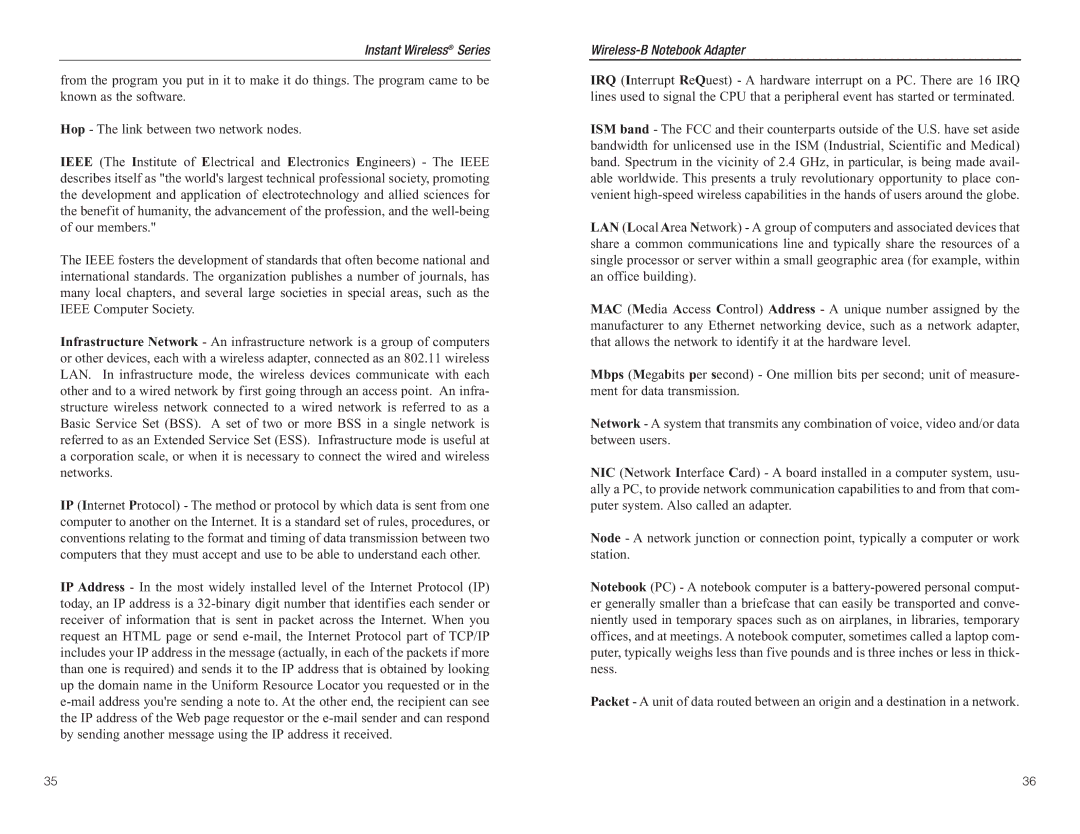Instant Wireless® Series
from the program you put in it to make it do things. The program came to be known as the software.
Hop - The link between two network nodes.
IEEE (The Institute of Electrical and Electronics Engineers) - The IEEE describes itself as "the world's largest technical professional society, promoting the development and application of electrotechnology and allied sciences for the benefit of humanity, the advancement of the profession, and the
The IEEE fosters the development of standards that often become national and international standards. The organization publishes a number of journals, has many local chapters, and several large societies in special areas, such as the IEEE Computer Society.
Infrastructure Network - An infrastructure network is a group of computers or other devices, each with a wireless adapter, connected as an 802.11 wireless LAN. In infrastructure mode, the wireless devices communicate with each other and to a wired network by first going through an access point. An infra- structure wireless network connected to a wired network is referred to as a Basic Service Set (BSS). A set of two or more BSS in a single network is referred to as an Extended Service Set (ESS). Infrastructure mode is useful at a corporation scale, or when it is necessary to connect the wired and wireless networks.
IP (Internet Protocol) - The method or protocol by which data is sent from one computer to another on the Internet. It is a standard set of rules, procedures, or conventions relating to the format and timing of data transmission between two computers that they must accept and use to be able to understand each other.
IP Address - In the most widely installed level of the Internet Protocol (IP) today, an IP address is a
IRQ (Interrupt ReQuest) - A hardware interrupt on a PC. There are 16 IRQ lines used to signal the CPU that a peripheral event has started or terminated.
ISM band - The FCC and their counterparts outside of the U.S. have set aside bandwidth for unlicensed use in the ISM (Industrial, Scientific and Medical) band. Spectrum in the vicinity of 2.4 GHz, in particular, is being made avail- able worldwide. This presents a truly revolutionary opportunity to place con- venient
LAN (Local Area Network) - A group of computers and associated devices that share a common communications line and typically share the resources of a single processor or server within a small geographic area (for example, within an office building).
MAC (Media Access Control) Address - A unique number assigned by the manufacturer to any Ethernet networking device, such as a network adapter, that allows the network to identify it at the hardware level.
Mbps (Megabits per second) - One million bits per second; unit of measure- ment for data transmission.
Network - A system that transmits any combination of voice, video and/or data between users.
NIC (Network Interface Card) - A board installed in a computer system, usu- ally a PC, to provide network communication capabilities to and from that com- puter system. Also called an adapter.
Node - A network junction or connection point, typically a computer or work station.
Notebook (PC) - A notebook computer is a
Packet - A unit of data routed between an origin and a destination in a network.
35 | 36 |
